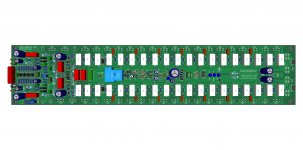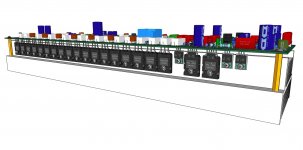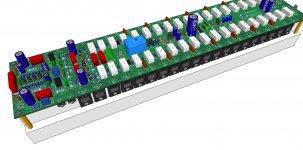There is a build guide done Neil did one for the entire build. As of now, the only thing is getting the boards in... last I heard they were 56% done.
There is nothing wrong with the Badger, it's proven and sounds awesome. Depending on skill level, the Badger will be a bit easier to build.
There is nothing wrong with the Badger, it's proven and sounds awesome. Depending on skill level, the Badger will be a bit easier to build.
Is there a build guide done? a spesific one, for the boards that is avalible? is boards avalible? wel some are. a group buy of half the amp. As far as i know, the spooky board is not developed yet. And thats halvf the point of this amp.. So there will be some time untill the boards and buldguide is available.There is a build guide done Neil did one for the entire build. As of now, the only thing is getting the boards in... last I heard they were 56% done.
There is nothing wrong with the Badger, it's proven and sounds awesome. Depending on skill level, the Badger will be a bit easier to build.
Everything is done and it will happen in less than 2 months, that is of course unless something unforeseeable happens.There wil be some time untill the boards are redely avalible and a detailed buildguide is availible. it will not happend in 2 monthts.
half the point of this amp is to choose between wolverine and spoky..
The cascode I suggested is actually proposed to me by Cordell in his book thread.
"I normally recommend caution in regard to the type of circuit you are using to bootstrap the input cascodes; I'm not crazy about injecting extra current into the LTP tail circuit. I might have used an emitter follower into whose emitter I would have flowed that current. I prefer the driven cascode that is driven by a replica of the feedback signal, which, under normal conditions, is pretty much the same as the common mode signal."
dado
the Pioneer Spec 2, was the first commercial amp to use the cascode, the Leach super amp in the early 70's also has this capcodes..i built a lot of Leach super amps, and i can say the sound was so much better than any ss amp i have built so far then in the 70's...when fidelity and power are sought for...
Last edited:
So. yoy are one of the many that can garantie that it works toprfectionthe Pioneer Spec 2, was the first commercial amp to use the cascode, the Leach super amp in the early 70's also has this capcodes..i built a lot of Leach super amps, and i can say the sound was so much better than any ss amp i have built so far then in the 70's...when fidelity and power are sought for...
So. yoy are one of the many that can garantie that it works toprfection
i built around 30 of the super leach amps in the 70's and two honey badgers several years ago, they both sounded very good......i guess it is up to the individual to appreciate these amps...but for me these amps are awesome....
we have a new design using the 3RU heatsinks with 7 quads of output trannies....
Attachments
Hello, Did you pair the transistors when building? I am mainly talking about the KSC3503 transistors which are only available in version D and the ksa1381 which are only available in version E.The ksc3503 D that I have have an hfe of 84 to 89 and the ksa1381 E have an hfe of 118 to 127. Do you think that will work? Impossible to find ksc3503 in version E. Cordially
Hi all!
I built a HB earlier this year and I've been extremely happy with the results. I work on audio equipment so I've listened to a lot of amps in my system and the only unit that beat my HB in my opinion was a Pass Labs X250.5, and only just!
I have a question regarding the input capacitor. I run a Bruce Heran SRPP tube preamp which uses an output capacitor to block DC. I'm curious if anyone is running the HB without an input cap and if it's worth doing. There were plenty of older designs that had switchable input caps to run direct coupling and I'm tempted to add a similar circuit to mine in case I am testing direct coupled preamps.
I built a HB earlier this year and I've been extremely happy with the results. I work on audio equipment so I've listened to a lot of amps in my system and the only unit that beat my HB in my opinion was a Pass Labs X250.5, and only just!
I have a question regarding the input capacitor. I run a Bruce Heran SRPP tube preamp which uses an output capacitor to block DC. I'm curious if anyone is running the HB without an input cap and if it's worth doing. There were plenty of older designs that had switchable input caps to run direct coupling and I'm tempted to add a similar circuit to mine in case I am testing direct coupled preamps.
Give it a go... I don't think you are going to hear much difference for the peace of mind, but there's nothing that can't be replaced in a Badger either. I'd be more concerned for the speakers, unless you built in that protection as well... mine has it and a soft start.
To be honest, a half decent coupling cap does not affect the sound. It was/is a fad unsupported by testing. Expectation bias at work here. Having said this, I know there are folks who will fight me to the death on this. If your capacitor does actually affect the sound quality, there is something wrong with it. I have seen expensive "audiophool" approved capacitors leaky with poor DA, but a quality part does not have any affect on sound quality as long as there is no signal voltage built up across that part. By definition, there isn't.
I'll say one thing. I have seen preamps throw DC out the signal jacks. Single ended caps can leak or fail. I strongly feel it isn't worth the risk. I've seen it happen.
I'll say one thing. I have seen preamps throw DC out the signal jacks. Single ended caps can leak or fail. I strongly feel it isn't worth the risk. I've seen it happen.
...unless you built in that protection as well.
Yes, yes, yessss!!!! I had a pre-amp that decided to output some DC, feeding into my Pass F5 without a DC blocking cap at the input, and without speaker protection at the output. This happened while I was not there, and when I got home there was a bad smell of burned voice coils. I am glad nothing caught fire. No more amps without DC blocking and speaker protection for me!To be honest, a half decent coupling cap does not affect the sound. ... I strongly feel it isn't worth the risk. I've seen it happen.
Should be perfectly fine to not use an input coupling cap,Hi all!
I built a HB earlier this year and I've been extremely happy with the results. I work on audio equipment so I've listened to a lot of amps in my system and the only unit that beat my HB in my opinion was a Pass Labs X250.5, and only just!
I have a question regarding the input capacitor. I run a Bruce Heran SRPP tube preamp which uses an output capacitor to block DC. I'm curious if anyone is running the HB without an input cap and if it's worth doing. There were plenty of older designs that had switchable input caps to run direct coupling and I'm tempted to add a similar circuit to mine in case I am testing direct coupled preamps.
If you are sure you will never have a preamp connected that will output DC.
If you need to use a cap and are worried about sound, just use a good poly cap bigger than needed, and bypass it with others like a wima 0.1uF cap also
Keeping C2 at the standard value of 270pf
Using the standard 4.7uf cap will give you a low pass frequency cut off -3dB point of about 1.5hz
Using the standard 4.7uf cap will give you a low pass frequency cut off -3dB point of about 0.68hz
I see no reason to deviate from the standard value.
BTW the high pass frequency cut off -3dB point of about 500khz and the UGCF is about 770khz using standard value for C7, C8
Using the standard 4.7uf cap will give you a low pass frequency cut off -3dB point of about 1.5hz
Using the standard 4.7uf cap will give you a low pass frequency cut off -3dB point of about 0.68hz
I see no reason to deviate from the standard value.
BTW the high pass frequency cut off -3dB point of about 500khz and the UGCF is about 770khz using standard value for C7, C8
If you are worried about sound quality of the input cap, check for low input DC and then put a jumper wire across the cap and try to hear a difference. Good luck.
Cap quality is a thing in loudspeaker xovers, where low impedance / high currents are involved. Not so with DC blocking caps at amp inputs.
Cap quality is a thing in loudspeaker xovers, where low impedance / high currents are involved. Not so with DC blocking caps at amp inputs.
- Home
- Amplifiers
- Solid State
- diyAB Amp - The "Honey Badger"


